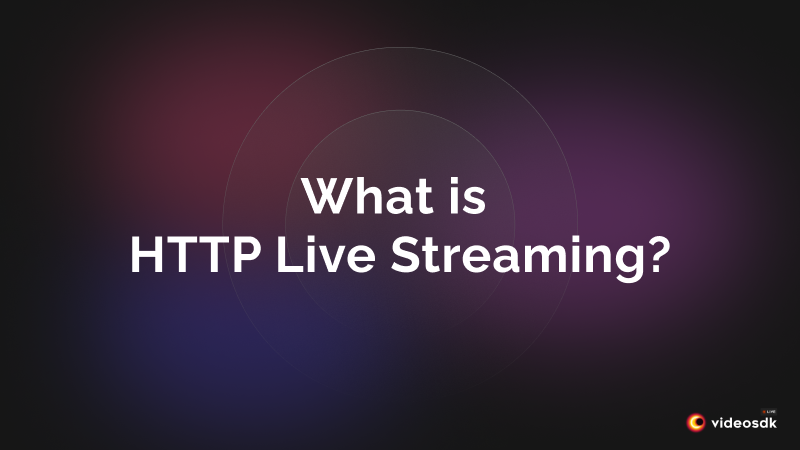What is HTTP Live Streaming (HLS)?
HTTP Live Streaming (HLS) changes the way videos are sent over the internet by automatically changing video quality to match how fast your internet is. This means videos play smoothly on any kind of device without stopping to buffer. Made by Apple and used everywhere, HLS breaks videos into small, smart pieces and can switch between different quality levels, so you hardly ever have to wait for videos to load. It's a top choice for people who put videos on the internet.
Advantages of HLS
- Adaptive Bitrate Streaming: HLS's adaptive streaming capability allows the client device to switch between different bitrate streams based on available network bandwidth. This ensures optimal playback quality regardless of the user's internet speed.
- Wide Compatibility: HTTP Live Streaming is supported by a broad range of devices, including iOS and Android devices, web browsers, and more. This widespread compatibility makes it a versatile choice for content delivery.
- Reduced Buffering: The segmented nature of HLS, with each segment containing a few seconds of content, minimizes buffering times. This results in a smoother streaming experience, especially when network conditions vary.
How Does HLS Work?
HTTP Live Streaming (HLS) Architecture Overview
HTTP Live Streaming operates on a client-server model, where the server generates a series of media files and playlists that the client downloads and plays sequentially. The key components of HLS include:
- Encoding: Converts video data using H.264 or H.265 encoding for broad compatibility.
- Segmenting: Divides the video into short segments, creating multiple quality levels and an index file for stream navigation.
- Manifest Files: Lists available streams and their qualities to assist client selection.
- CDNs: Enhances streaming performance globally by minimizing latency.
Adaptive Bitrate Streaming: A core feature of HLS that adjusts the video quality based on the user's network conditions, preventing buffering by switching between different bitrate streams.
HLS's Advantages: Offers a consistent viewing experience across varying network conditions, ensures wide device and browser compatibility, and improves user experience with minimal buffering.
Wide Compatibility with Devices and Browsers
HLS's compatibility extends to a wide range of devices and browsers, making it an accessible solution for content providers. Whether users are on mobile devices or desktops, HLS ensures seamless playback across platforms.
Enhanced User Experience with Reduced Buffering
The segmented nature of HLS and adaptive bitrate streaming contribute to a superior user experience. Reduced buffering times and the ability to adapt to varying network speeds make HTTP Live Streaming a reliable choice for streaming services aiming to provide high-quality content delivery.
How VideoSDK Enhances HLS (HTTP Live Streaming)?
Introduction to VideoSDK
VideoSDK is a powerful set of real-time audio and video SDKs that empower developers across the USA & India to seamlessly integrate audio-video conferencing and interactive live streaming into web and mobile applications. It offers complete flexibility, scalability, and control over the streaming experience.
Enhancing HLS with VideoSDK:
- Interactive Communication: Enables real-time audio and video interactions.
- Scalability and Flexibility: Allows streaming services to grow and adapt to user demands.
- Customization and Reliability: Offers tailored streaming experiences with dependable performance.
Benefits of Using VideoSDK with HLS
- Seamless Integration: VideoSDK seamlessly integrates with HLS, providing developers with the tools needed to enhance streaming capabilities within their applications.
- Customization: VideoSDK allows developers to customize the streaming experience, ensuring it aligns with the unique requirements of their applications.
- Reliability: With VideoSDK, developers can build robust and reliable streaming applications, ensuring a consistent and high-quality experience for end-users.
Technical Aspects of VideoSDK and HLS Integration
API Documentation and Developer Resources
Developers can leverage comprehensive API documentation provided by VideoSDK to integrate HLS seamlessly. The documentation includes detailed guides, code samples, and support resources to facilitate a smooth integration process.
Compatibility with Different Platforms and Devices
VideoSDK ensures cross-platform compatibility, enabling developers to create applications that work seamlessly on a variety of devices, including smartphones, tablets, and desktops. This versatility is crucial for reaching a broad audience.
Performance Optimization Tips for HLS Streaming with VideoSDK
To optimize HLS streaming performance with VideoSDK, developers should consider the following:
- Bandwidth Adaptation: Leverage VideoSDK's capabilities to adjust bandwidth dynamically, aligning with HLS's adaptive streaming for an optimal user experience.
- Caching and Content Delivery: Implement effective caching mechanisms and leverage CDNs to enhance content delivery speed and reduce latency.
- Quality of Service (QoS) Monitoring: Integrate tools for monitoring QoS to track streaming performance and identify areas for improvement.
Best Practices for Implementing HLS Streaming
Tips for Optimizing HLS Streaming Performance
- Use Efficient Codecs: Employ modern and efficient video and audio codecs to ensure high-quality streaming at lower bitrates.
- Optimize Segmentation: Adjust the duration of media segments to balance between reducing buffering and minimizing the number of requests.
- CDN Optimization: Choose a reliable CDN and optimize its configuration to ensure efficient content delivery.
Ensuring Compatibility Across Devices and Browsers
- Browser Support: Verify the compatibility of HTTP Live Streaming with popular browsers and implement fallback options for non-supporting environments.
- Device Testing: Conduct thorough testing on various devices to ensure a consistent streaming experience across platforms.
Security Considerations for HLS Streaming
- Encryption: Implement encryption to secure the content and prevent unauthorized access.
- Tokenization: Use tokenization to control access to streaming content and protect against unauthorized sharing.
Integration Tips for VideoSDK and HLS:
- Comprehensive API Support: Utilize detailed documentation for seamless integration.
- Cross-Platform Compatibility: Ensure smooth operation across all devices and platforms.
- Performance Optimization: Implement bandwidth adaptation, caching, and quality monitoring for superior streaming quality.
Optimizing HLS Streaming:
- Use efficient codecs and optimize segment duration for better streaming performance.
- Leverage a reliable CDN and ensure browser and device compatibility.
- Prioritize security through encryption and tokenization to protect content.
Support and Integration with VideoSDK:
- VideoSDK fully supports HLS, enabling developers to incorporate adaptive, high-quality streaming into applications.
- Compatible with a wide range of web and mobile frameworks, offering flexibility in development environments.
